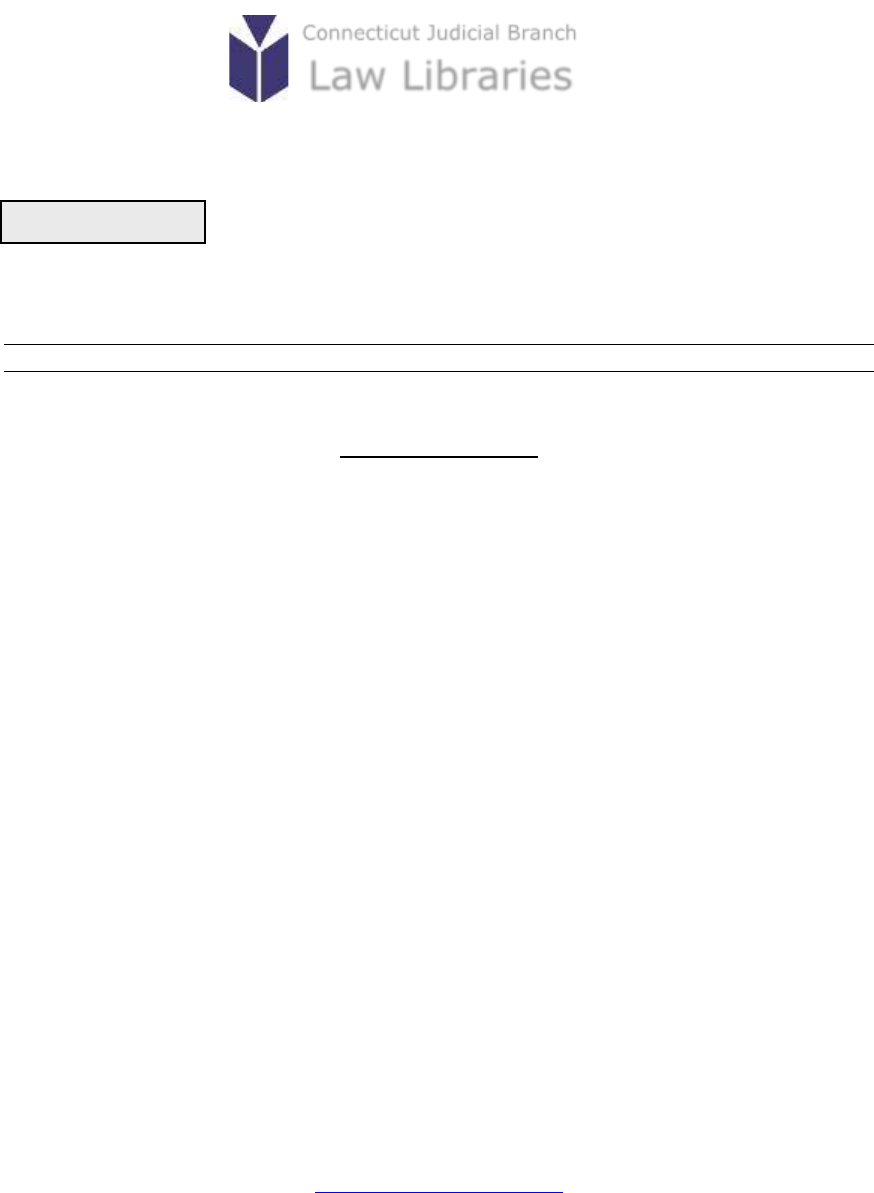
Surface Water - 1
Connecticut Judicial Branch
Law Libraries
Copyright © 2000-2022, Judicial Branch, State of Connecticut. All rights reserved.
Surface Water in Connecticut
A Guide to Resources in the Law Library
Table of Contents
Introduction .................................................................................................... 3
Section 1: Between Private Landowners .............................................................. 4
Section 2: From Public Roads or Ways .............................................................. 12
Table 1: Cause of Action .............................................................................. 22
Figure 1: Form 104.6 ................................................................................... 24
Prepared by Connecticut Judicial Branch, Superior Court Operations,
Judge Support Services, Law Library Services Unit
lawlibrarians@jud.ct.gov
2022 Edition

Surface Water - 2
These guides are provided with the understanding that they represent only a
beginning to research. It is the responsibility of the person doing legal research to
come to his or her own conclusions about the authoritativeness, reliability, validity,
and currency of any resource cited in this research guide.
View our other research guides at
https://jud.ct.gov/lawlib/selfguides.htm
This guide links to advance release opinions on the Connecticut Judicial Branch website
and to case law hosted on Google Scholar and Harvard’s Case Law Access Project.
The online versions are for informational purposes only.
References to online legal research databases refer to in-library use of these
databases. Remote access is not available.
Connecticut Judicial Branch Website Policies and Disclaimers
https://www.jud.ct.gov/policies.htm

Surface Water - 3
Introduction
• Surface waters: “those casual waters which accumulate from natural
sources and which have not yet evaporated, been absorbed into the earth, or
found their way into a stream or lake. The term does not comprehend waters
impounded in artificial ponds, tanks or water mains.” Taylor v. Conti, 149
Conn. 174, 178, 177 A.2d 670 (1962).
• “‘Surface water’ is a term which has been defined or used variously. A few
of the definitions embody statements which would imply that it is a term
appropriate to be applied to all fresh water upon the surface of the earth, not
ponded, which is not that of a watercourse. Other authorities while giving a
definition which affords no logical foundation for such a broad use of the
term, act upon the assumption that all non-ponded fresh water is either
surface or stream water. The better and more generally stated definitions,
and those which permit a consistent application productive of just results,
confine surface water within more definite limits.” Thompson v. New Haven
Water Co., 86 Conn. 597, 603, 86 A. 585 (1913).
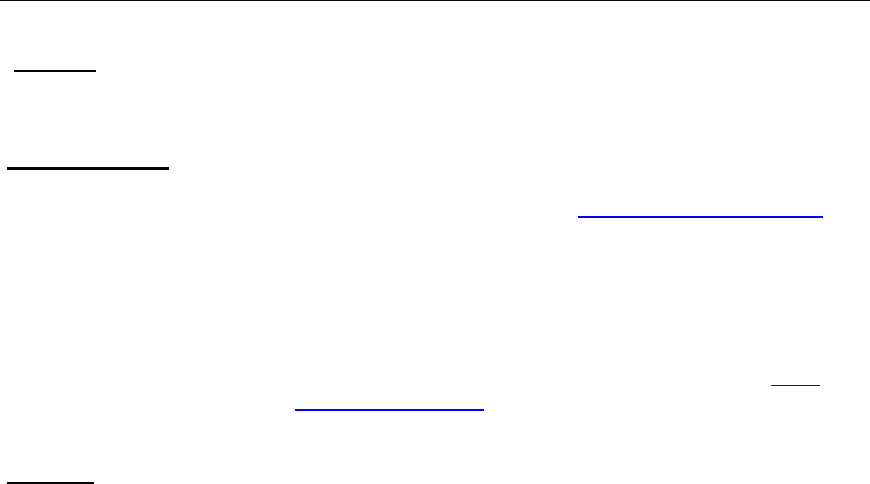
Surface Water - 4
Section 1: Between Private Landowners
A Guide to Resources in the Law Library
SCOPE:
• Bibliographic resources relating to actions against private
property owners who alter flow of surface water causing
injury to owners of adjacent property.
DEFINITIONS:
• Common enemy doctrine: “briefly stated, is that the
owner of land may repel or divert surface water from its
land on to that of another.” Page Motor Co. v. Baker, 182
Conn. 484, 487, 438 A.2d 739 (1980).
• Rule of reasonable use: “the landowner, in dealing
with surface water, is entitled to take only such steps as
are reasonable, in light of all the circumstances of
relative advantage to the actor and disadvantage to the
adjoining landowners, as well as social utility.” Page
Motor Co. v. Baker, 182 Conn. 484, 488-489, 438 A.2d
739 (1980).
FORMS:
• 1 Library of Connecticut Civil Complaints for Business
Litigation, Connecticut Law Tribune, 2010.
Form 3-005 State Court Complaint – Diversion of
Surface Waters
• 2 Connecticut Practice Series, Connecticut Civil Practice
Forms, 4th ed., by Joel M. Kaye et al., Thomson West,
2004, with 2021-2022 supplement (also available on
Westlaw).
Form 104.6. Injunction against interference with flow
of surface water. See Figure 1.
• 1A Am Jur Pleading & Practice Forms Injunctions,
Thomson West, 2014 (also available on Westlaw).
§ 154. Complaint, petition, or declaration - Storm
water discharged onto plaintiff's land - House
damaged
• 24C Am Jur Pleading & Practice Forms Injunctions,
Thomson West, 2018 (also available on Westlaw).
§ 248. Complaint, petition, or declaration—
Concentration and injurious discharge of
surface water—By adjoining landowner—
Negligent maintenance of inoperative
drainage system
§ 269. Motion—By landowner—For temporary
restraining order—To enjoin adjacent
landowner from discharging water onto
property
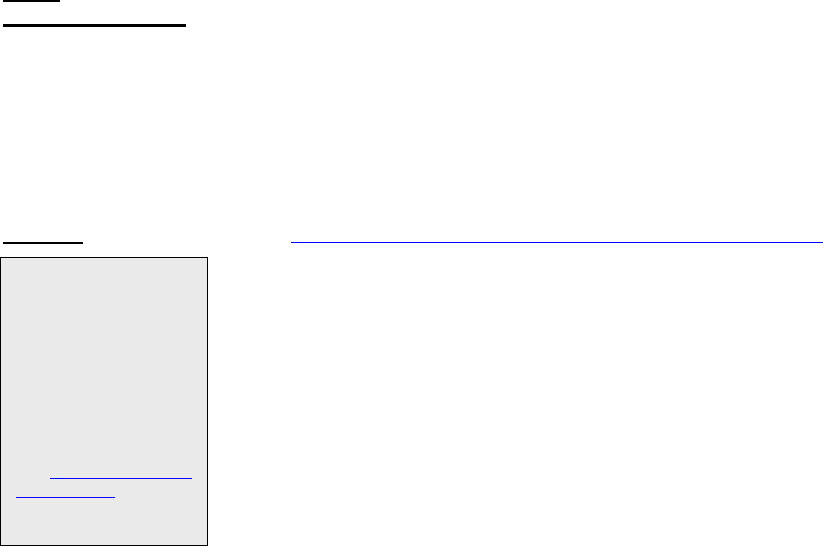
Surface Water - 5
• 48 COA 2d 397, Cause of Action for Damage Caused by
Diversion of or Change in Flow of Surface Water by Eric
M. Larsson, J.D., 2011 (also available on Westlaw.)
§ 50. Sample complaint
§ 51. Sample complaint for damages and injunctive
relief due to obstruction and diversion of
stream by levee
• 87 Am Jur Trials 423 Proof of Landowner's Unreasonable
Interference with Surface Water Drainage, 2003 (also
available on Westlaw.)
§ 29. Complaint by lower landowner seeking relief
for upper owner's acceleration and increase in
volume of surface waters discharged onto lower
land
§ 30. Complaint by upper landowner seeking relief
from lower landowner's obstruction of natural
drainage by erection of earthen embankment
● 2 A Practical Guide to Disputes between Adjoining
Landowners—Easements, by James H. Backman, Matthew
Bender, 1989, with 2022 supplement (also available on
Lexis).
Chapter 13. Water-Related Property Rights
§ 13.09 Practice Aids
[2] Forms
[b] Complaint for Flooding by Diversion of
Uncontrolled Surface Waters
JURY
INSTRUCTIONS:
• 87 Am Jur Trials 423, Proof of Landowner's Unreasonable
Interference with Surface Water Drainage (2003). Also
available on Westlaw.
Model Jury Instructions
§ 46. Rule of reasonable use
§ 47. Liability for unreasonable alteration of surface
water drainage—Augmenting natural drainage
§ 48. Determination of "unreasonableness" of
Defendant's conduct as question of fact
CASES:
• JMS Newberry, LLC v. Kaman Aerospace Corporation,
149 Conn. App. 630, 90 A.3d 249 (2014). “The record
supported the trial court's finding that the plaintiff failed
to present any evidence that would establish that the
defendants were maintaining an alteration that diverted
surface water off their property; although the complaint
attributed the increased flow of water across the
plaintiff's property to the unnatural grading of the
defendants' property, there was no evidence in the
record that the defendants' property had been altered so
as to discharge water off of their property in a different
course than its natural flow, the evidence submitted by
the defendants conclusively established that neither they
nor their predecessor had altered the property, and
Once you have Once
you have identified
useful cases, it is
important to update
the cases before you
rely on them.
Updating case law
means checking to
see if the cases are
still good law. You
can contact your local
law librarian to learn
about the tools
available to you to
update cases.

Surface Water - 6
affidavits of the plaintiff's expert fell short of establishing
material issues of fact concerning whether the
defendants were maintaining an unnatural grade on their
property or diverting surface water off of their property.”
• Hurlburt v. DeRosa, 137 Conn. App. 463, 49 A.3d 249
(2012). “The court concluded that the plaintiff failed to
present sufficient evidence to establish his right to
enforce the drainage easement because he failed to
present evidence that a natural watercourse was on the
defendants’ property or had ever been on the
defendants’ property. Our careful review of the record
supports the court’s determination.”
• Walton v. New Hartford, 223 Conn. 155, 162, 612 A.2d
1153 (1992). “In their appeal, the Parsons claim that the
trial court improperly concluded that the plaintiffs had
granted to the Parsons a license, rather than an
easement, to use the plaintiffs' property. We disagree.”
• Ferri v. Pyramid Construction Company, 186 Conn. 682,
686, 443 A.2d 478 (1982). “In Page Motor, this court
substituted the reasonable use doctrine for the first
branch of the rule of Tide Water Oil. We announced that
a repelling landowner would no longer enjoy immunity in
dealing with surface water. Instead, we held (pp. 488-
89) that, in dealing with surface water, the landowner
would be ‘entitled to take only such steps as are
reasonable, in light of all the circumstances of relative
advantage to the actor and disadvantage to the adjoining
landowners, as well as social utility.’ In increasing the
possible liability of a landowner repelling surface waters,
we did not address, and certainly did not diminish, the
existing liability of a landowner diverting surface water
under the second branch of the rule of Tide Water Oil.”
• Berin v. Olson, 183 Conn. 337, 439 A.2d 357 (1981).
“The fact that the court awarded damages does not
preclude the plaintiff from receiving injunctive relief. See
Taylor v. Conti, supra (award of both damages and
injunctive relief); 42 Am.Jur.2d, Injunctions 40, p. 780; 5
Clark, Waters and Water Rights 458. "For over one
hundred years in this state, we have recognized the
general power of equity to afford relief by injunction and
damages for injury caused by a nuisance created by the
unreasonable conduct on one's own property of an
otherwise lawful activity. [Citations omitted.]" Nair v.
Thaw, 156 Conn. 445, 451-52, 242 A.2d 757 (1968)
(award of money damages and injunction restraining
certain activity of the defendant).”
• Page Motor Co. v. Baker, 182 Conn. 484, 488, 438 A.2d
739 (1980). “We now feel that the inflexibility of the old

Surface Water - 7
rule [common enemy doctrine], as correctly reported by
the trial referee, should be modified so as to allow some
reasonable latitude. By way of dictum, we are now
inclined to adopt what some jurisdictions have termed
the reasonableness of use rule.”
• Falco v. James Peter Associates, Inc., 165 Conn. 442,
446, 335 A.2d 301 (1973). “Moreover, one who
maintains such an alteration in his land [causing an
increase in volume of surface water which flows onto the
land of others], though it was created by his predecessor
in title, may, after a request to remove it, be held liable
for the continuing injury.”
• Taylor v. Conti, 149 Conn. 174, 177, 177 A.2d 670
(1962). “A landowner cannot use or improve his land so
as to increase the volume of the surface waters which
flow from it onto the land of others, nor can he discharge
surface waters from his land onto the land of others in a
different course from their natural flow, if by so doing he
causes substantial damage.”
Unreported Decisions:
• Chase v. Tusia, Superior Court, Judicial District of
Windham at Putnam, No. CV04-4000354-S (May 8,
2007) (43 Conn. L. Rptr. 688). “‘Surface water cases first
abandoned the law of property in favor of the law of torts
in Basset v. Salisbury Mfg. Company, 43 N.H. 569
(1862)... While under the law of property, water dripping
from an overhanging eve was actionable, the law of
torts, which governs surface water, requires the water to
do damage before a right of action accrues.’ Street v.
Woodgate Condominium Assoc., Superior Court, judicial
district of Middlesex at Middletown, Docket No. CV 01-
096955 (January 13, 2004, Gordon, J.).”
• Agnello v. Urbano, Superior Court, Judicial District of
New Haven at New Haven, No. CV00-0273689-S (Oct.
24, 2002) (2002 WL 31501032). “The court finds that
the defendants' actions violated the second branch of the
Tide Water test. The defendants improved their land and
caused the water to impermissibly flow upon the
plaintiffs' property.”
• Gentile v. Reed, Superior Court, Judicial District of
Stamford - Norwalk at Stamford, No. CV91-0115805-S
(July 22, 1997) (1997 WL 435842). “‘The plaintiffs rely
primarily on Falco v. James Peter Associates, Inc., 165
Conn. 442, 446, 335 A.2d 301 (1973), for the
proposition that a successor in title can be held liable for
the actions of his predecessor in title in that one who
maintains such an alteration in his land, though it was

Surface Water - 8
created by his predecessor in title, may, after a request
to remove it, be held liable for the continuing injury.ꞌ The
referee, however, distinguished this case by noting that
the water diverted by the defendants' predecessors in
title in Falco drains towards the workshop and house
cellar and subject them ꞌto substantial continuing water
seepage.ꞌ Id., 444. In this case the referee said that the
filling on the subject property fell ꞌfar short of . . .
continuing harm.ꞌ Therefore, the conclusion that the
defendants are not responsible for the maintenance of a
nuisance is legally and logically consistent with the facts
found by the referee. Romano v. Derby, supra. 42 Conn.
App. 628.”
WEST KEY
NUMBERS:
• Water Law
V. Diffuse Surface Waters
(A) In General
#1160. In general
#1161. What are surface waters
#1162. Rights, duties, and liabilities in general
#1163. Rights to capture, own, or use surface water
#1164. Rule of reasonableness in general
#1165. Obstruction or repulsion of flow in general
#1166. Common enemy doctrine; right to avoid
surface waters
#1167. Right to have natural drainage maintained
#1168-1173. Drainage or discharge
#1174. Persons liable
#1175-1182. Easement of drainage
#1183-1187. Transfer of easement or other right of
drainage
#1188. Abandonment, forfeiture, or other loss of
right or privilege of drainage
#1189. Pollution
#1190. Rain water and eaves drip
(B) Actions or Other Proceedings to Determine,
Establish, and Protect Rights
#1195. In general
#1196. Rights of action and defenses in general
#1197. Economic loss as grounds
#1198. Nuisance
#1199. Preliminary injunction
#1200-1211. Proceedings and relief
#1212. Review
#1213. Costs and attorney fees
DIGESTS:
• West’s Connecticut Digest
Water Law
V. Diffuse Surface Waters
A. In general
§§ 1160-1190
B. Actions or Other Proceedings to Determine,
Establish, and Protect Rights

Surface Water - 9
§§ 1195-1213
• Dowling’s Digest: Waters
§ 5. Surface water
● West's ALR Digest
Water Law
V. Diffuse Surface Waters
A. In general
§§ 1161-1190
B. Actions or Other Proceedings to Determine,
Establish, and Protect Rights
§§ 1198-1212
ENCYCLOPEDIAS:
• 1 Am. Jur. 2d Adjoining Landowners, Thomson West,
2016 (Also available on Westlaw).
§ 35 Water, Snow or Ice Precipitating onto Adjoining
Premises
• 78 Am. Jur. 2d Waters, Thomson West, 2013 (Also
available on Westlaw).
III. Particular Types of Waters or Water Bodies
D. Surface Waters
§§ 189-190 In general
§§ 191-199 Drainage; Interference with natural flow
§ 191 Common-enemy doctrine
§ 192 Civil law rule
§§ 200-210 Application of general rules;
circumstances affecting rights and liabilities
§§ 211-216 Remedies and actions
VI. Liability for Water-related Injury or Damage
Property Damage In General
§ 395 Generally
§ 396 Overflow resulting from obstruction by debris or
waste
§ 397 Overflow from wells
§ 398 Injury resulting from defect in artificial
underground drain, conduit, or pipe
§ 399 Matters affecting liability; defenses
§ 400 –Act of God as causative factor
• 93 CJS Injunctions, Thomson West, 2013 (Also available
on Westlaw).
V. Surface water
§§ 247-251. In general
§§ 252-256. Rights, duties, and liabilities
§§ 257-265. Natural flow or drainage and obstruction
thereof
§§ 266-274. Artificial drainage and obstruction thereof
§§ 275-279. Creation and transfer of easement or
right of drainage
§§ 280-291. Actions for damages
§§ 292-296. Injunction
Encyclopedias and
ALRs are available in
print at some law
library locations and
accessible online at
all law library
locations.
Online databases are
available for
in-library use.
Remote access is not
available.
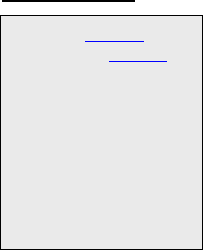
Surface Water - 10
• 87 Am Jur Trials 423, Proof of Landowner's Unreasonable
Interference with Surface Water Drainage, 2003 (also
available on Westlaw).
I. Legal background
II. Rules governing interference with surface water
drainage
III. Application of rules to particular forms of
interference
IV. Defenses
V. Damages and other relief
VI. Elements of proof
VII. Model pleadings
VIII. Proof of upper landowner's unreasonable change
in surface water drainage
IX. Model jury instructions
• 109 POF 3d 403, Unreasonable Alteration of Surface
Drainage, 2009 (also available on Westlaw).
• 48 COA 2d 397, Cause of Action for Damage Caused by
Diversion of or Change in Flow of Surface Water, by Eric
M. Larsson, J.D., 2011 (also available on Westlaw).
• 88 ALR 4th 891, Annotation, Liability for Diversion of
Surface Water By Raising Surface Level of Land, by Martin
J. McMahon, J.D., 1991 (also available on Westlaw).
• 42 ALR 4th 462, Annotation, Extinguishment by
Prescription of Natural Servitude For Drainage Of Surface
Waters, by Francis M. Dougherty, J.D., 1985 (also
available on Westlaw).
• 93 ALR 3d 1193, Annotation, Modern Status Of Rules
Governing Interference With Drainage Of Surface Waters,
by Janet Fairchild, J.D., 1979 (also available on Westlaw).
TREATISES:
• 2 Connecticut Practice Series, Connecticut Civil Practice
Forms, 4th ed., by Joel M. Kaye et al., Thomson West,
2004, with 2022 supplement (also available on Westlaw)
Authors' Comments following Form 104.6
• Connecticut Law of Torts, 4th ed., by Douglass B. Wright
et al., Atlantic Law Book Co., 2018, with 2021
supplement.
§ 18. Connecticut decisions on trespass
See §18b.
• Connecticut Torts: The Law and Practice, 2d ed., by
Frederic S. Ury et al., LexisNexis, 2021.
Chap. 14 Recovery for Injury to Property
You can contact us
or visit our catalog
to determine which
of our law libraries
own the treatises
cited.
References to online
databases refer to
in-library use of
these databases.

Surface Water - 11
• 2 A Practical Guide to Disputes between Adjoining
Landowners—Easements, by James H. Backman, Matthew
Bender, 1989, with 2022 supplement (also available on
Lexis).
§ 13.04. Neighboring landowner disputes arising from
uncontrolled surface waters on private
property
• The Law of Easements and Licenses in Land by Jon W.
Bruce and James W. Ely, Jr, Thomson West, 2001, with
2022 supplement (also available on Westlaw).
§ 5:37. Special-purpose prescriptive easements
• Law of Water Rights and Resources, by A. Dan Tarlock,
Thomson West, 2015, with 2020 supplement (also
available on Westlaw).
§ 3:11. Waters subject to riparian rights
§ 3:12 —Surface waters
§ 3:13. — Diffused surface waters
§ 3:14. — — Ownership of diffused surface waters
• Water Law in a Nutshell, 4
th
ed., by David H. Getches,
Thomson West, 2009.
Chapter 7. Diffused surface waters
• Neighbor Law, 10
th
ed., by Cora Jordan and Emily
Doskow, Nolo, 2017.
Chapter 15. Water
• Waters and Water Rights, 3
rd
ed., by Robert E. Beck and
Amy K. Kelley, LexisNexis, 2009.
• Waters and Water Rights, by Robert E. Beck, Michie,
1991.
§ 4.05(b). Diffused surface waters
§ 6.02. Categories of surface water
• Restatement of the Law Second, Torts, 1979, with 2021
supplement (also available on Westlaw).
§§ 833. Interference with the flow of surface
waters
LAW REVIEWS:
• Patricia A. Ayars, Comments, The Flow of Surface Water
Law in Connecticut, 14 Connecticut Law Review 601
(1982).
• B Clifford Davis, The Law Of Diffused Surface Water In
Eastern Riparian States, 6 Connecticut Law Review 227
(1973-74).
Public access to law
review databases is
available on-site at
each of our law
libraries.
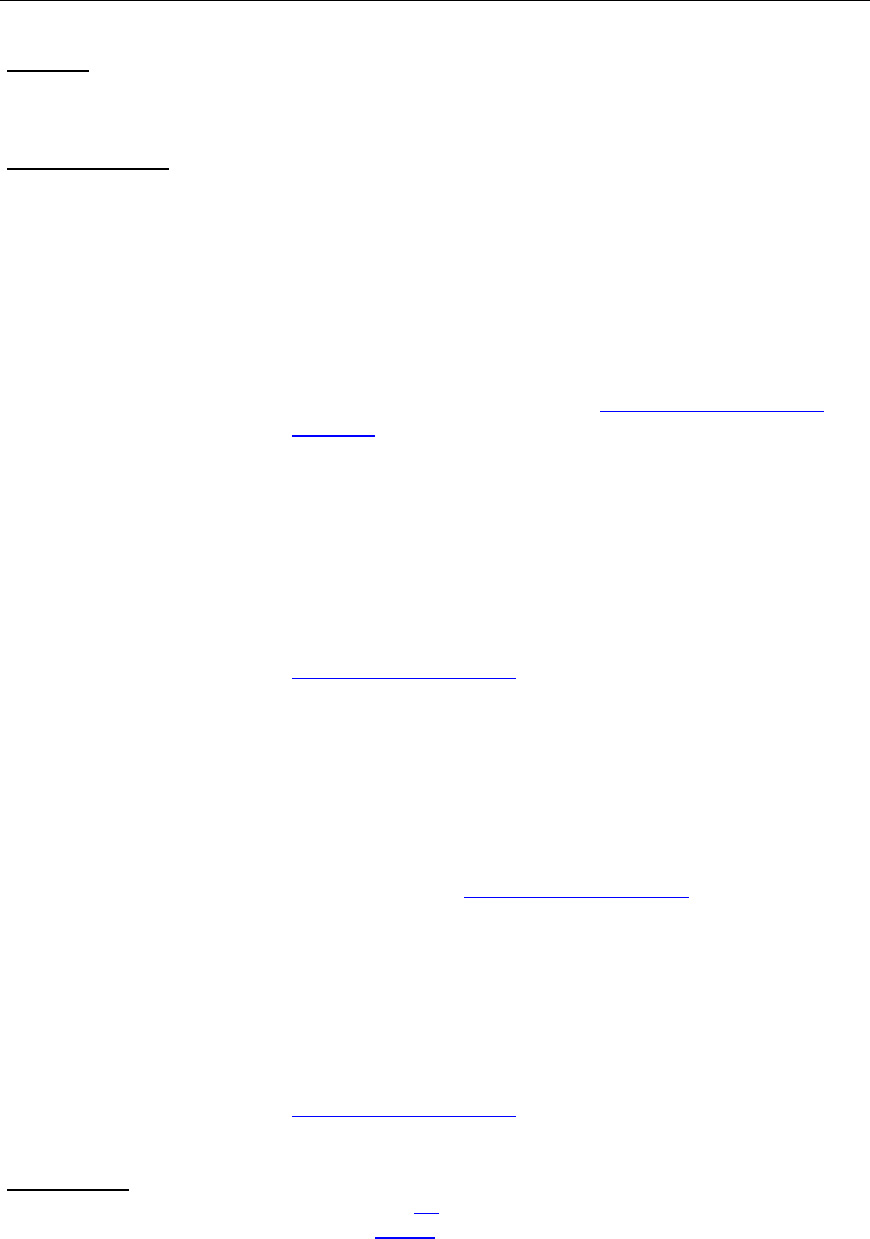
Surface Water - 12
Section 2: From Public Roads or Ways
A Guide to Resources in the Law Library
SCOPE:
• Bibliographic resources relating to actions against the
State or municipalities for damage caused by drainage
of surface waters
DEFINITIONS:
• “The common-law rule provides that a person cannot
gather surface water on his or her own land in an
artificial volume and turn it onto a neighbor's land in an
increased volume to the neighbor's injury. This rule
also applies to governmental agencies engaged in
highway maintenance. [General Statutes of
Connecticut] Section 13a-138 (a) limits the liability for
such water diversion only where the party charged with
maintaining the highway complies with the statute by
draining the water in a manner that causes the least
damage to the affected land.” Hutchinson v. Town of
Andover, 49 Conn. App. 781, 786, 715 A.2d 831
(1998).
• Ministerial: “‘A ministerial act is one which a person
performs in a given state of facts, in a prescribed
manner, in obedience to the mandate of legal
authority, without regard to or the exercise of his own
judgment [or discretion] upon the propriety of the act
being done. (Internal quotation marks omitted.) Blake
v. Mason, 82 Conn. 324, 327, 73 A. 782 (1909)′.”
Northrup v. Witkowski, 332 Conn. 158, 169,
210 A.3d 29 (2019).
• Discretionary: “In contrast, when an official has a
general duty to perform a certain act, but there is no
‘city charter provision, ordinance, regulation, rule,
policy, or any other directive [requiring the government
official to act in a] prescribed manner,′ the duty is
deemed discretionary. Violano v. Fernandez, supra,
280 Conn. 323.” Northrup v. Witkowski, 332 Conn.
158, 169, 210 A.3d 29 (2019).
• Ministerial vs. Discretionary Acts: “Generally, a
municipal employee is liable for the misperformance of
ministerial acts, but has a qualified immunity in the
performance of governmental acts. . . . Governmental
acts are performed wholly for the direct benefit of the
public and are supervisory or discretionary in nature.”
Northrup v. Witkowski, 332 Conn. 158, 167, 210 A.3d
29 (2019).
STATUTES:
• Conn. Gen. Stat. (2021)
Chapter 97. Municipalities: General Provisions.
§ 7-147. Regulation of obstructions in waterways
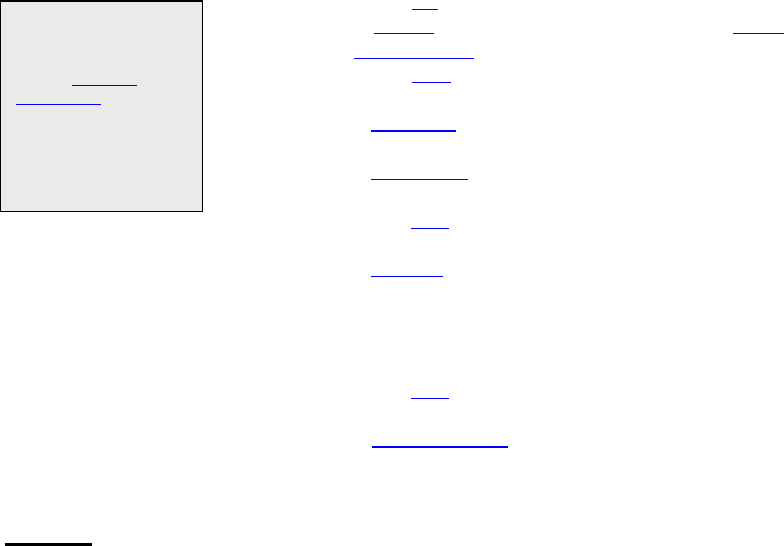
Surface Water - 13
Chapter 98. Municipal Powers
§ 7-148 Scope of municipal powers (2022
Supplement)
Chapter 238. Highway construction and
maintenance
§ 13a-138. Highways may be drained into private
lands
§ 13a-138a. Limitation on actions for drainage
damage
Chapter 439. Department of Energy & Environmental
Protection. State Policy.
§ 22a-6u. Notification requirements re discovery
of contamination of soil or water. Exceptions.
Content of notice. Acknowledgement of receipt.
Posting of notice. Civil penalty. Forwarding of
notice.
Chapter 925. Statutory Rights of Action and
Defenses
§ Sec. 52-557n. Liability of political subdivision
and its employees, officers and agents. Liability
of members of local boards and commissions.
FORMS:
• 2 Connecticut Practice Series, Connecticut Civil Practice
Forms, 4th ed., by Joel M. Kaye et al., Thomson West,
2004, with 2022 supplement (also available on
Westlaw).
Form 104.6. Injunction against interference with
flow of surface water. See Figure 1.
• 1A Am Jur Pleading & Practice Forms Adjoining
Landowners, Thomson West, 2014 (also available on
Westlaw).
§ 157. Overflow from municipal drains and fills on
defendants’ lands - House damaged
§ 159. Municipal dam on stream running through
plaintiff’s land – Land flooded and rendered
unproductive
• 24C Am Jur Pleading & Practice Forms Waters,
Thomson West, 2018 (also available on Westlaw).
§ 246. Complaint, petition, or declaration—
Concentration and injurious discharge of
surface water—By state agency
§ 249. — By county highway
§ 250. — By highway drainage ditch
§ 251. — By street drain
You can visit your
local law library or
search the most
recent statutes and
public acts on the
Connecticut General
Assembly website to
confirm that you are
using the most up-
to-date statutes.
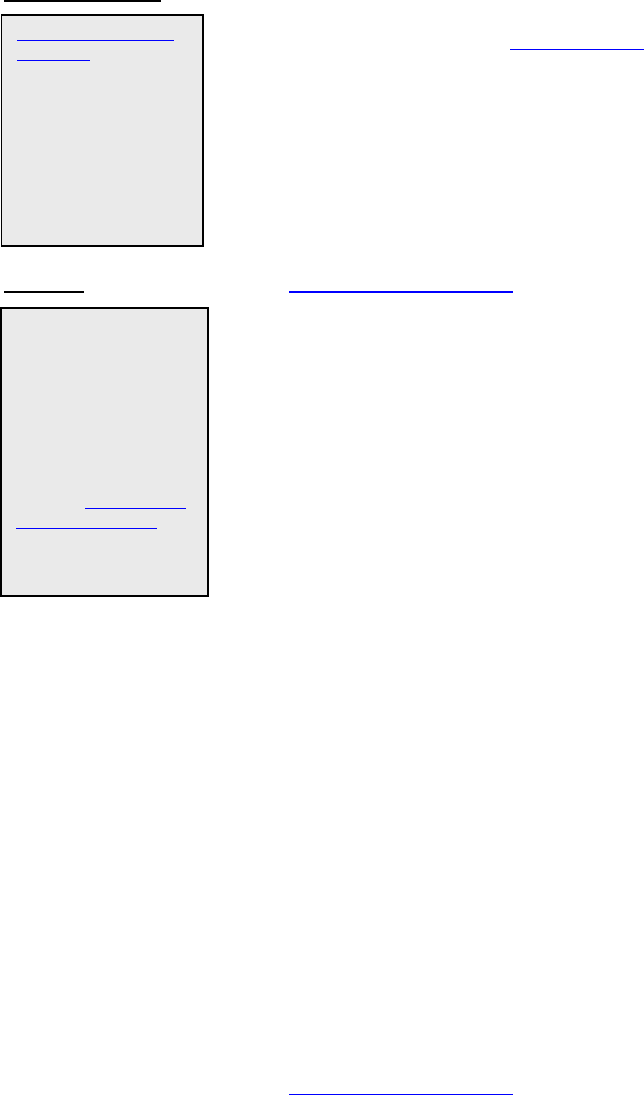
Surface Water - 14
LEGISLATIVE:
• Drainage from State Highways, Paul Frisman,
Connecticut General Assembly. Office of Legislative
Research, Report No. 2002-R-0609. (July 1, 2002).
“You asked who is responsible for correcting
flooding problems when the discharge of water from
a state highway culvert flows onto private property
in a wetlands area. You specifically asked about the
responsibility, if any, of the Department of
Transportation (DOT) in a particular instance.”
CASES:
• Northrup v. Witkowski, 332 Conn. 158, 160, 210 A.3d
29 (2019). “This certified appeal requires us to
consider the continued vitality of this court’s decision in
Spitzer v. Waterbury, 113 Conn. 84, 88, 154 A. 157
(1931), which held that ‘[t]he work of constructing
drains and sewers, as well as that of keeping them in
repair, is ministerial, and the municipality is responsible
for negligence in its performance.’ The
plaintiffs…brought this action against the defendants,
the borough of Naugatuck (town) and several town
officials, claiming, inter alia, that the defendants’
negligence in maintaining and repairing the town’s
storm drains and drainage pipes had caused the
repeated flooding of the plaintiffs’ residence. The
plaintiffs now appeal, upon our granting of their
petition for certification, from the judgment of the
Appellate Court affirming the trial court’s granting of
the defendant’s motion for summary judgment on the
ground that the negligence claims were barred
because, under more recent cases refining and
clarifying Spitzer, the maintenance of storm drains and
drainage systems is a discretionary function subject to
governmental immunity, rather than a ministerial
function, the negligent performance of which can
subject a municipality to liability. Northrup v.
Witkowski, 175 Conn. App. 223, 250, 167 A.3d 443
(2017). We disagree with the plaintiffs’ claim that the
Appellate Court improperly failed to follow Spitzer
because we conclude that decision must be overruled
in light of modern case law governing the distinction
between ministerial and discretionary duties. Accord-
ingly, we affirm the judgment of the Appellate Court.”
• Northrup v. Witkowski, 175 Conn. App. 223, 225, 167
A.3d 443 (2017). "The plaintiffs claim on appeal that
the court improperly determined that (1) the
defendants were entitled to governmental immunity on
all counts as a matter of law because the acts or
omissions of which they complained were discretionary
rather than ministerial in nature, (2) the identifiable
person-imminent harm exception to governmental
Once you have
identified useful
cases, it is important
to update the cases
before you rely on
them. Updating case
law means checking
to see if the cases
are still good law.
You can contact your
local law librarian to
learn about the tools
available to you to
update cases.
Office of Legislative
Research reports
summarize and
analyze the law in
effect on the date of
each report’s
publication. Current
law may be different
from what is
discussed in the
reports.

Surface Water - 15
immunity did not apply to the flooding at issue because
the plaintiffs were not subject to imminent harm, and
(3) the allegations of recklessness directed against the
individual defendants could not be sustained as a
matter of law. We disagree with the plaintiffs and, for
the reasons that follow, affirm the judgment of the trial
court."
● Silberstein v. 54 Hillcrest Park Associates, LLC, 135
Conn. App. 262, 269 (2012). “On the basis of this
evidence, we conclude that the defendants voluntarily
undertook to construct and maintain the roads, drains
and storm sewers in Hillcrest Park. The defendants
therefore had a duty to maintain and repair the storm
drains and sewers in the Hillcrest Park neighborhood.
II
The plaintiffs argue that the defendants' maintenance
of the roads, storm drains and sewers in Hillcrest Park
is a ministerial function. We disagree and conclude,
under the circumstances of this case, that the
defendants' maintenance of the roads, storm drains
and sewers was discretionary in nature.”
• Herasimovich v. Town of Wallingford, 128 Conn. App.
413, 421, 17 A.3d 502 (2011). “Specifically, the
plaintiffs claim that the court improperly concluded that
the parties intended the term ‘surface water’ to include
both precipitation falling on Highland Avenue and water
that naturally flows off of property adjacent to Highland
Avenue. The plaintiffs argue that the parties intended
the meaning of the term ‘surface water’ to be limited
solely to precipitation falling on Highland Avenue.”
• Boyne v. Town of Glastonbury, 110 Conn. App. 591,
598, 955 A.2d 645 (2008). “In the present case, even
if we assume that § 13a-138a does not limit expressly
a cause of action under § 13a-138(b), the most
suitable limitation period is the fifteen year period
provided by § 13a-138a. Section 13a-138, in general,
authorizes municipalities to drain water from public
highways into or through the land of another under
certain circumstances. A cause of action for a violation
of § 13a-138 does not change significantly by pleading
circumstances that violate subsection (b) rather than
circumstances that violate subsection (a).”
• Johnson v. Town of North Branford, 64 Conn. App. 643,
650, 781 A.2d 346 (2001). “Section 13a-138a serves
as a limitation on actions for drainage damages
brought pursuant to § 13a-138. Section 13a-138a
provides in relevant part that ‘[n]o action shall be
brought by the owner of land adjoining a public

Surface Water - 16
highway ... for recovery of damage of such property ...
by reason of any draining of water into or through such
land by any town, city, borough or other political
subdivision of the state pursuant to subsection (a) of
section 13a-138, but within fifteen years next after the
first occurrence of such drainage, except that if such
drainage first occurred prior to October 1, 1981, no
such action shall be brought after October 1, 1986.’”
• Hutchinson v. Town of Andover, 49 Conn. App. 781,
785, 715 A.2d 831 (1998). “Our Supreme Court has
said that the statute ‘permits drains to be built only
when necessary, and if there is a reasonable
alternative course open, that course must be taken.’
(Emphasis added.) Postemski v. Watrous, 151 Conn.
183, 188, 195 A.2d 425 (1963). Here, there is no
dispute that it is necessary for the town to divert some
water onto the plaintiffs' land and the only issue is
which system will cause the least damage to the land.”
• Walton v. New Hartford, 223 Conn. 155, 168, 612 A.2d
1153 (1992). “The trial court concluded that ‘the
plaintiffs have sustained their burden of proof that the
Town of New Hartford has failed to properly maintain
“the enclosed catchbasin and the discharge system....”’
The court then ordered that, pursuant to the easement,
‘the plaintiffs are entitled to an order directing the town
to periodically, as necessary, clear the catchbasin on
the plaintiffs' property as well as that located on Lair
Road which feeds into the easement pipes.’”
• Hillman v. Greenwich, 217 Conn. 520, 521-522, 587
A.2d 99 (1991). “The plaintiff, Howard B. Hillman,
brought an action for damages and injunctive relief
against the defendant, the town of Greenwich, alleging
that unlawful and unreasonable drainage of surface
storm water by the defendant had damaged the
plaintiff’s property.”
• Spitzer vs. City of Waterbury, 113 Conn. 84, 154 A.
157 (1931). Overruled to the extent it concluded that
municipal duties with respect to the maintenance and
repair of drains and sewers are ministerial in nature.
Northrup v. Witkowski, 332 Conn. 158, 161, 210 A.3d
29 (2019).
Unreported Decisions:
• Pyskaty v. City of Meriden, Superior Court, Judicial
District of New Haven at New Haven, CV126005514S
(August 3, 2015) (2015 WL 5236948) (2015 Conn.
Super. LEXIS 2035). “Similar to Great Food Corp.,
there are allegations in the present case that Meriden

Surface Water - 17
failed to remove debris that clogged the detention
basin and made a deliberate choice to cut trees and
leave them in the vicinity of the detention basin
whereby the tree logs could float into and block the
egress pipe, causing the stream to flood onto the
property. In addition, unlike Pluhowsky, it is unclear
how the logs, branches, tree trunks, and/or debris
made their way to the egress pipe in the Frary
detention basin. Therefore, on the basis of the evidence
submitted by the plaintiffs, there is a genuine issue of
material fact as to whether Meriden participated in the
creation of a nuisance by way of its positive act in
cutting down trees in the Frary detention basin and
leaving the cut tree trunks, logs, branches, and debris
to float in the basin, block and/or clog a pipe, which
resulted in the stream overflowing and flooding the
property.”
• DeMarco v. City of Middletown, Superior Court, Judicial
District of Middlesex, No. MMXCV116006185S (April 3,
2014) (58 Conn. L. Rptr. 4) (2014 WL 1721935). “The
defendant attempts to argue that the holding in Spitzer
does not extend to the type of sewage system involved
here by citing to Rouleau v. Suffield, Superior Court,
judicial district of Hartford, Docket No. CV–06–
5007179–S (January 16, 2013, Sheriden, J.) [55 Conn.
L. Rptr. 372]. The factual situation in Rouleau involved
flooding resulting from rising water levels in Stony
Brook on the upstream side of a concrete structure
because the culvert openings were blocked by water-
borne debris. The plaintiffs alleged negligence in the
design, construction and maintenance of a structure
intended to span and provide passage by vehicles and
pedestrians over an existing stream or watercourse. As
seen from the facts of Rouleau, the court did not face
the issue of governmental immunity in the context of
the type of sewage system that is involved here in this
present matter.” (Footnote 2.)
“The defendant also argues that because of one
particular allegation in the plaintiff’s complaint, the acts
are discretionary. The defendant argues that ‘the
actions of the City in inspecting, fixing, and advising
the plaintiffs about the sewage system were
discretionary acts for which, pursuant to § 52–
557n(a)(2)(B), governmental immunity applies.′ In
support, the defendant cites to cases that have set
forth the broad principle that the exercise of duties
involving inspection are generally considered
discretionary acts entitled to governmental immunity.
Although true, it is worth noting, however, that these
cases are not in the context of sewer systems, and the
principle to which the defendant alludes is a principle of

Surface Water - 18
general applicability and does not necessarily control
the issue at hand. Furthermore, given that the entirety
of the plaintiffs’ complaint is based on the construction,
repair, and maintenance of the sewer system, the
plaintiff’s sole allegation pertaining to ‘inspection,′ an
allegation that is generally considered discretionary, is
not sufficient enough to impose governmental
immunity. See Barankowsky v. Waterbury, supra,
Superior Court, Docket No. CV–96–133416 (court
found that although allegation pertaining to ‘design′ of
sewer system is usually discretionary, because the
complaint contained other allegations regarding the
construction and repair, governmental immunity did
not apply); Librandi v. Stamford, supra, Superior
Court, Docket No. CV–90–0111346–S (court found
governmental immunity did not apply even though
complaint contained allegation that city failed to
exercise due care and proper inspection of sewage
system).” (Footnote 3.)
• Rouleau v. Town of Suffield, Superior Court, Judicial
District of Hartford, No. HHD-CV065007179-S. (Jan.
16, 2013) (55 Conn. L. Rptr. 372) (2013 WL 593874).
“A close examination of the Spitzer facts and the
Spitzer holding lead this court to believe that its logic
and its holding should be limited and should not be
expanded to apply to the factual situation presented in
this case. As previously noted, the Spitzer court
reasoned that in order to carry out its statutory duty to
maintain the highways within its limits, the municipality
was required to collect and dispose of the ‘surface
water falling upon them.′ Creating and maintaining a
‘system′ to complete that ‘required′ operation was held
to be a ministerial function, incidental to a statutorily
prescribed duty, allowing for no exercise of judgment
or discretion.
In the present case, the plaintiffs allege negligence in
the design, construction and maintenance of a
structure intended to span and provide passage by
vehicles and pedestrians over an existing stream or
watercourse. Of necessity, a naturally occurring
watercourse flows under and through the structure, but
neither the structure nor the watercourse is part of a
‘system′ built to carry out a required function which is
‘incidental′ to a statutorily prescribed duty. The logical
structure of Spitzer is, in fact, fairly limited in its
application. It does not extend to every case where
government channels or conveys a liquid, and the
plaintiffs have failed to provide facts or law to suggest
that it should apply in this case.”

Surface Water - 19
• Great Foods Corp. v. Town of New Canaan, Superior
Court, Judicial District of Fairfield at Bridgeport, No.
CV095026011S (August 22, 2011) (2011 WL
4089770). “The first count of the revised complaint
claims that because of the defendant's violation of
§13a-138, the plaintiff has suffered and continues to
suffer damages. In count two, a nuisance claim, the
plaintiff incorporates paragraphs one through eleven of
count one and further alleges that the runoff from the
surface water was due to an affirmative act by the
defendant in designing, grading, constructing and
maintaining its property. Count two further alleges that
this water has a natural tendency to create and inflict
damage to private property in close proximity to its
property, and that the danger is continuous and
interferes with the right of adjacent landowners and
occupiers to enjoy their property, including the plaintiff.
In count three, a negligence claim, the plaintiff
incorporates paragraphs one through eleven of count
one and further alleges that the defendant has a duty
to maintain its property in such a manner as to prevent
excess runoff of surface water onto adjoining property.
On March 15, 2011, the defendant filed a motion for
summary judgment on the grounds that as to count
one, the plaintiff cannot establish a cause of action
under §13a-138, and, as to counts two and three, the
defendant is entitled to governmental immunity under
General Statutes §52-557n(a)(2)(B) as the plaintiff
cannot establish that the imminent harm exception
applies to it.”
WEST KEY
NUMBERS:
• Highways
VII. Construction, Improvement, and Repair
#120. Drainage
(.5). In general
(1). Power and duty as to drainage
(2). Rights and remedies of abutting owners in
general
(3). Injunction
(4). Damages and actions therefor
(5). Drainage districts
• Municipal Corporations
XII. Torts.
(D). Defects or obstructions in sewers, drains, and
water courses
#835. Obstruction or diversion of flow of surface
water
# 845. Actions for injuries

Surface Water - 20
DIGESTS:
• West’s Connecticut Digest
Water Law
V. Diffuse Surface Waters
A. In general
§§ 1160-1190
B. Actions or Other Proceedings to Determine,
Establish, and Protect Rights
§§ 1195-1213
• Dowling’s Digest: Waters
§ 5. Surface water
● West's ALR Digest
Water Law
V. Diffuse Surface Waters
A. In general
§§ 1161-1190
B. Actions or Other Proceedings to Determine,
Establish, and Protect Rights
§§ 1198-1212
ENCYCLOPEDIAS:
• 39 Am Jur 2d Highways, Streets and Bridges, Thomson
West, 2019 (Also available on Westlaw).
§ 123. Interference with surface waters
§ 124. Preventing flow from adjoining land
§ 125. Discharge of collected surface water
• 93 CJS Injunctions, Thomson West, 2013 (Also
available on Westlaw).
V. Surface water
§§ 247-251. In general
§§ 252-256. Rights, duties, and liabilities
§§ 257-265. Natural flow or drainage and
obstruction thereof
§§ 266-274. Artificial drainage and obstruction
thereof
§§ 275-279. Creation and transfer of easement or
right of drainage
§§ 280-291. Actions for damages
§§ 292-296. Injunction
• 87 Am Jur Trials 423, Proof of Landowner's
Unreasonable Interference With Surface Water
Drainage, 2003 (Also available on Westlaw).
• 65 POF 3d 311, Governmental Liability for Injury to
Landowner's Property from Road Construction Activities
on Neighboring Land, 2002 (Also available on
Westlaw).
• 48 POF 3d 419, Recovery under Property Insurance for
Loss Due To Surface Water, Sewer Backup and Flood,
1998 (Also available on Westlaw).
Encyclopedias and
ALRs are available in
print at some law
library locations and
accessible online at
all law library
locations.
Online databases are
available for
in-library use.
Remote access is not
available.
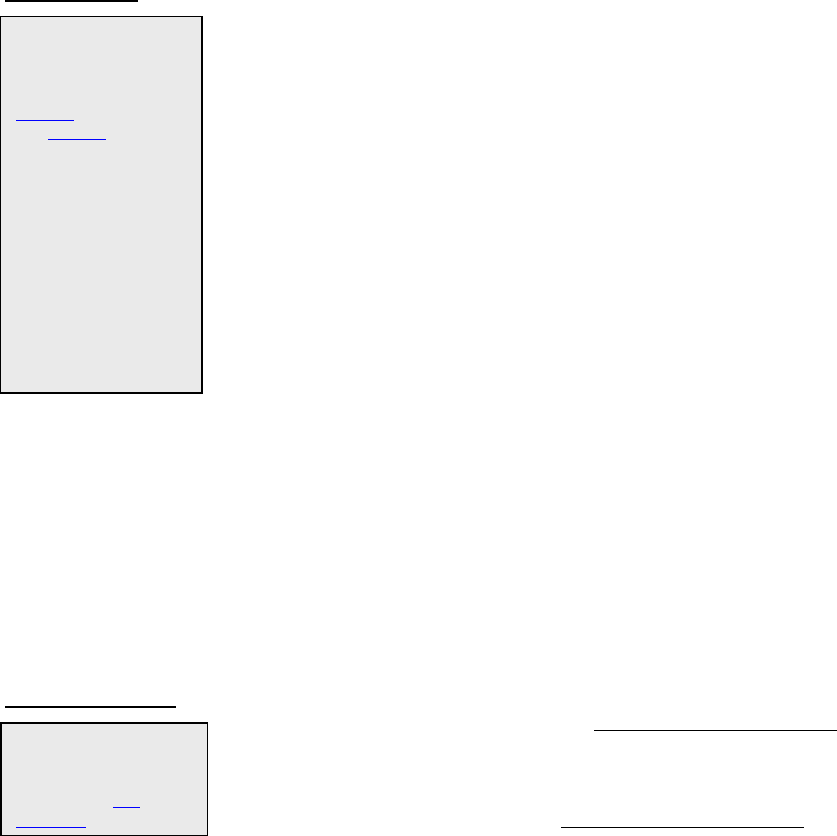
Surface Water - 21
• 109 POF 3d 403, Unreasonable Alteration of Surface
Drainage, 2009 (Also available on Westlaw).
• 54 ALR 6th 201, Municipal Liability for Damage
Resulting from Obstruction or Clogging of Drain or
Sewer, by Michael A. Rosenhouse, J.D., 2010 (Also
available on Westlaw).
TREATISES:
• 2 Connecticut Practice Series, Connecticut Civil Practice
Forms, 4th ed., by Joel M. Kaye et al., Thomson West,
2004, with 2022 supplement (also available on
Westlaw)
Authors' Comments following Form 104.6
• 18A The Law of Municipal Corporations, 3d ed. rev., by
Eugene McQuillin, Thomson West, 2021, with 2022
supplement (also available on Westlaw).
Chapter 53. Municipal liability for torts
§ 53.237. Surface water. In general
§ 53.238. Surface water; definitions
§ 53.239. Liability for public improvements;
“common enemy” rule
§ 53.241. Statutory provisions affecting
recovery
§ 53.242. Casting surface water on private land
• Water Law in a Nutshell, 4
th
ed., by David H. Getches,
Thomson West, 2009.
Chapter 7. Diffused surface waters
§ III B. State control of use of diffused surface
waters
• Restatement of the Law Second, Torts, 1979, with
2021 supplement (also available on Westlaw).
§§ 841-848. Interference with the use of water
(“Riparian rights”)
LAW REVIEWS:
• Patricia A. Ayars, Comments, The Flow of Surface
Water Law in Connecticut, 14 Connecticut Law Review
601 (1982).
• Clifford Davis, The Law of Diffused Surface Water In
Eastern Riparian States, 6 Connecticut Law Review 227
(1973-74).
Public access to law
review databases is
available on-site at
each of our law
libraries.
Each of our law
libraries own the
Connecticut treatises
cited. You can
contact us or visit
our catalog to
determine which of
our law libraries own
the other treatises
cited or to search for
more treatises.
References to online
databases refer to
in-library use of
these databases.
Remote access is not
available.

Surface Water - 22
Table 1: Cause of Action
Cause of action for damage caused
by diversion of or change in flow of surface water
48 COA 2d 397 (2011)
PRIMA FACIE CASE
§ 12
Elements
§ 13
—Negligence
§ 14
—Nuisance
§ 15
—Trespass
§ 16
Duty to control flow of surface water
§ 17
Breach of duty
§ 18
—Proof
§ 19
Harm to plaintiff or plaintiff’s property
§ 20
Proximate causation
DEFENSES
§ 21
Absence of duty
§ 22
Absence of duty by drainage easement, license, or servitude
§ 23
Absence of breach
§ 24
—Compliance with statute or governmental directive
§ 25
Intervening cause of harm
§ 26
—Plaintiff’s failure to take precautions to prevent harm
§ 27
—Act of God or other natural occurrence
§ 28
Sovereign immunity
§ 29
Absence of privity of contract
§ 30
Statute of limitations
§ 31
Laches
§ 32
Misleading representations; equitable estoppel
§ 33
Collateral estoppel or res judicata
PARTIES
§ 34
Parties who may bring action
§ 35
Persons potentially liable
Practice and Procedure
PROCEDURAL MATTERS
§ 36
Single or multiple cause of action
§ 37
Jurisdiction
§ 38
Limitations; time for bringing action
§ 39
Pleadings
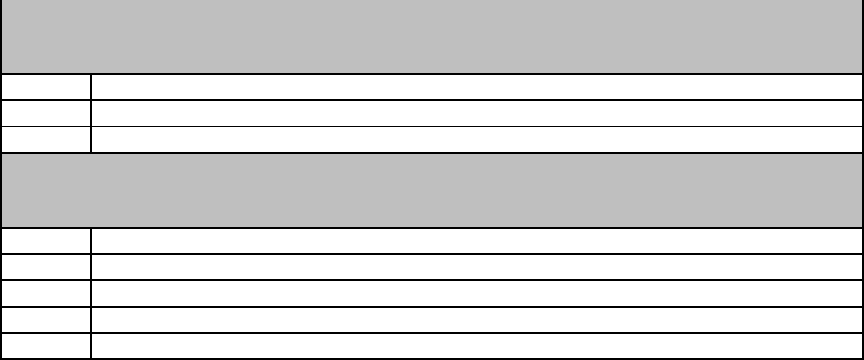
Surface Water - 23
PROOF
§ 40
Plaintiff’s proof
§ 41
—Proof of harm
§ 42
Defendant’s proof
REMEDIES AND RECOVERY
§ 43
Equitable relief
§ 44
—Type and scope of equitable relief
§ 45
Compensatory damages
§ 46
—Measure of damages
§ 47
Punitive damages
Surface Water - 24
Figure 1: Form 104.6
FORM 104.6
Injunction Against Interference with Flow of Surface Waters
COMPLAINT
1. The plaintiff is the owner of a certain piece or parcel of land, with the appurtenances
thereto, situated in the city of ________, and bounded and described as follows: [here
insert description]. On the premises he has a large garage in which he stores and
repairs automobiles.
2. The defendants are the owners of a contiguous piece of land which abuts the above
mentioned property of the plaintiff on the south, which premises are described as
follows: [here insert description].
3. Abutting the above described premises of both parties to the east is and for a long
time has been a railroad right of way on which are constructed tracks upon an
embankment higher than the lands of the parties.
4. The natural slope of land across the premises of both parties is from the northwest
to the southeast.
5. Prior to the construction of the railroad a small stream or watercourse ran across
the land of the plaintiff and away to the east over the land now occupied by the railroad
but by reason of the building of the embankment it was deflected to the west and has
ever since run in a definitely defined and marked course across the land of the
defendant.
6. The change was made more than fifteen years before the occurrences hereafter
stated and ever since the plaintiff has enjoyed and asserted the right to have the water
in this watercourse pass off over the defendant’s land, and the use of the watercourse
over the defendant’s land for that purpose has been open, continuous, uninterrupted,
with the knowledge and acquiescence of the defendant and his predecessors in title
and adversely to him and them.
7. Beginning on or about [date] the defendant has filled in the land on his premises
for the entire distance it abuts upon the land of the plaintiff until it is higher than the
land of the plaintiff, and has filled in the channel of the watercourse and wholly
obstructed it.
8. As a further result of the filling in of his premises by the defendant, he has caused
the surface water which falls upon it, instead of flowing away to the south as it normally
would, to flow northerly upon the land of the plaintiff, and thereby has greatly
increased the volume of surface water coming upon the plaintiff’s premises, and has
Surface Water - 25
so filled his land as to cause the surface water coming upon the plaintiff’s premises to
flow thereon not in a natural diffused manner but in several well defined channels,
which bring upon the plaintiff’s premises dirt and silt and wash channels through it.
9. As a result of the filling of his land by the defendant the waters coming to the
plaintiff’s premises from the north and surface water falling thereon and on the
defendant’s premises accumulate upon the plaintiff’s premises and remain standing
thereon to a considerable depth and create a nuisance and a condition dangerous to
the maintenance of the plaintiff’s structures now on the premises, and these conditions
and the deposits of dirt and the channels on the plaintiff’s land caused by defendant’s
acts seriously impair the plaintiff’s beneficial use of his premises.
The plaintiff claims
1. An injunction requiring the defendant to reopen the channel of the watercourse and
against placing obstructions therein.
2. That the defendant be enjoined from interfering with the natural flow of the surface
waters coming onto the plaintiff’s land.
3. Damages.
Notes
(P.B.1963, Form 349; P.B.1978, Form 104.6.)
